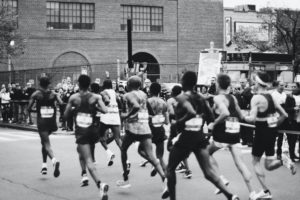Running 101

The history of running dates back thousands of years and spans the entire globe. From hunting to religious, military and political purposes, it has evolved into one of the most universally respected, admired and participated sports. With no age barrier, easy accessibility and minimal equipment necessary, it’s enjoyed by millions of people around the world for physical exercise, recreation, and competition, as well as social, economic and cultural reasons.
Race Distances
5K
A 5K is a 3.1 mile race and a typical training program is 4-8 weeks.
10K
A 10K is a 6.2 mile race and a typical training program is 8-12 weeks.
Half Marathon
A Half Marathon is a 13.2 mile race and a typical training program is 12-14 weeks.

The marathon is a long-distance running event that is over 120 years old, beginning with the first modern Olympics in 1896. The official distance is 42.195 kilometers or 26 miles and 385 yards.
The name Marathon originates from a Greek legend by the name of Philippides, who was a messenger in 490 BC. It is said that he ran from the battlefield of Marathon to Athens without stopping to announce that the Persians had been defeated in the Battle of Marathon, before suddenly collapsing and dying.
Inspired by the 1896 Summer Olympics in Athens, Greece, the Boston Marathon was established in 1897 and is the oldest continuously running marathon in the world.

The history of ultra running is as old as human civilization, when our early ancestors explored vast lands, sent messengers to communicate and used their extraordinary endurance to pursue prey.
An ultramarathon is any running distance longer than a marathon. The races are organized over a set distance or duration of time. The most common distances are 50 km, 100 km, 50 miles and 100 miles, while the most common races for time are 6hr, 24hr and multi-day events.
Most ultramarathons take place over varied terrain, such as trails, dirt roads and mountain paths, with obstacles like inclement weather, rugged terrain and elevation changes. Participation has increased 1,000% over the last decade as runners seek more extreme races.
The State of Running Today
The IAAF and RunRepeat recently published a report that analyzed running data and race results from 1986 to 2018.
-
Participation has skyrocketed – over the last 10 years the number of running participants has jumped by 57.8%, with over 1.1 million marathon runners last year.
-
People are older – the average age of runners in 1986 was 35.2 and in 2018 it was 39.3.
-
Female participation is on the rise – for the first time in history there are more female than male runners.
-
The top three nations with the most marathon runners are Germany, Spain and the Netherlands.
-
The top three countries with the largest proportion of runners are Ireland, the Netherlands and the United Kingdom.
-
More people are traveling to run in a race – the percentage of people traveling to a different country has risen from 0.2% to 3.5%.
-
The average finish time for a marathon is 4 hours and 32 minutes.
Five Tips to Get Started
It doesn’t matter whether you’re training for your first 5K or a marathon, the general structure remains the same.
-
Follow a Plan
Pick a race. Sign up and pay for it. Put it on your calendar. Tell your friends and family about it. This will help you stay focused, motivated and disciplined. Make sure it’s challenging, but specific and attainable, given your running experience and the amount of time you have dedicated to train.
-
Get the Gear
The beauty of running is that it requires minimal equipment and it can be done anytime/anywhere. However, there are a few items that will assist you in your training regiment.
Shoes
It’s best to start with two pairs of running shoes; distance and speed. It’s a good idea to have different shoes for specific workouts. Not only that, but studies show that alternating shoes reduces incidence of overuse injuries and it also extends the life of your shoes because the compression of the materials in the sole can often take more than 24 hours to fully re-expand after your run.
Distance shoes offer higher cushion and more stability to allow for less wear and tear on your body. They are typically used for long runs, easy runs and recovery runs. These shoes last 300 to 500 miles before you should consider getting a new pair.
Speed shoes are lighter and offer more agility to allow higher leg turnover. They are typically used for shorter runs, like speed work and tempo runs. These shoes typically last 200 to 400 miles because they have less material and are not as durable.
Watch
A dedicated running watch will assist you during workouts, help track progress and measure results. These days most smart watches have capabilities, such as heart rate monitoring, pace and distance tracking. Some of the more advanced watches have bells and whistles like Vo2 Max, cadence and recovery analysis, but they only add incremental value.
Running Belt or Arm Band
Useful to stash your phone, keys, gels and money.
Water Bottle
For runs longer than an hour it’s a good idea to carry water and nutrition. Some water bottles are integrated into running belts and there are also running-specific ergonomic handheld bottles that are molded to fit the curve of the hand. A strap keeps the bottle secure and a pocket allows a small spot to stash a car key or a gel.
-
Keep it Simple
Running is one of the most basic forms of human exercise and there is no reason to over complicate your training plan. Few people are able to run very far on their first day of running. If you are just starting out, use the run/walk method. For example, run for 30 seconds and walk for 60 seconds. Keep adjusting as you get more comfortable (run 45/walk 90, run 90/walk 30 and so on).
If you have some running experience and feel comfortable completing one mile without stopping, there are three key workouts that will get you to the finish line. Complete each of them 1x per week and use the other days for easy runs/recovery runs and cross-training workouts like cycling and strength training.
Long Run
The Long Run is the most important run of the week. The purpose of the long run is to increase mitochondrial production and boost the distribution of the capillaries (blood vessels) in your muscles. This delivers more nutrients and fuel into the muscles to produce energy. Long runs also help your body become more efficient at burning fat for fuel, which saves more energy and spares your limited glycogen (carbohydrate) stores. Lastly, it improves length strength and resistance to fatigue.
The cardinal rule for long runs is to go slow and steady – a fully conversational, relaxed pace or 30-60 seconds slower than you goal marathon pace. Heart rate should be 65% – 75% of your maximum. Time is more important than distance in these workouts. Aim to add 5-10 minutes from one week to the next, building up from 90 minutes to a maximum of 3 hours over the course of your marathon training plan. Eat something or use energy gels every 20 to 30 minutes on any runs over 60 minutes. Complete this workout in your distance shoes.
Tempo Run
The Tempo Run is a highly beneficial workout that will boost your endurance and speed by improving your body’s ability to clear lactate from your blood. Lactate is a natural byproduct generated by the production of energy in the body. At a certain point or threshold, your body becomes overrun with lactate, which causes that intense burning sensation and fatigue during a hard effort. The more you train your body at higher intensities, the longer you can go before feeling the burn because it becomes more efficient at clearing lactate.
Tempo runs are comfortable, hard efforts. It’s the pace at which you can no longer comfortably speak a full sentence. It should be similar to your half-marathon pace or 75% to 80% of your maximum heart rate and should last no longer than 60 minutes, including a 10 minute warm-up and 10 minute cool-down. Complete this workout in your speed shoes.
Speed Run
Speed runs are tough, fast repeats done at short distances. They improve running economy, which is the amount of oxygen consumed at a given pace. If you think about it like a car, you’ll get better gas mileage. Another benefit of speed workouts is increased leg turnover, which improves running cadence. Lastly, fast repeats provide a mental challenge and make your marathon pace feel easier.
There are several variations of speed runs that you should include in your training plan, but only perform one per week.
400 meter repeats (start with 8 and build to 12), 800 meter repeats (start with 4 and build to 8), 1 mile repeats (start with 3 and build to 6) and 2 mile repeats (start with 2 and build to 4). A good rule of thumb is to perform one repeat and then rest (walk or jog) for twice the amount of time before performing another repeat. These are best completed on a track or by using the interval function on your watch.
Sample Weekly Plan
Monday: Rest Day
Tuesday: Tempo Run 45 minutes
Wednesday: Strength Training 30 minutes + Cycling 30 minutes
Thursday: Speed Run 4 x 800 meter repeats
Friday: Easy/Recovery Run 5 Miles
Saturday: Strength Training 30 minutes + Elliptical 30 minutes
Sunday: Long Run 90 minutes
-
Build Mileage Steadily
Running like all exercise, breaks down the body – all the way from the cellular level to the physiological systems. With proper rest the body repairs, rebuilds and comes back stronger than before, which leads to fitness gains. However, without adequate rest the body falls deeper and deeper into deficit, eventually breaking down to the point where training becomes counterproductive and performance is sacrificed.
Hard days, such as tempo runs and speed runs should be followed by easy days like recovery runs, cross-training or rest days. Listen to your body for warning signs and adjust as necessary. Sore muscles, aches, pains and fatigue are a normal part of training, but err on the side of caution. Running in particular is a high impact sport, unlike other endurance sports like cycling and swimming, and more susceptible to injury.
Most common running injuries occur when athletes increase their weekly running volume too quickly. As a rule of thumb, do not increase running volume or duration by more than 10% on a weekly basis. For example, if your current weekly mileage is 20 miles, next week you should run no more than 22 miles.
-
Focus on Recovery
The quantity and quality of the food you eat and the sleep you get can make or break your training plan.
Nutrient-dense foods, such as good fats (monounsaturated and polyunsaturated), complex carbohydrates (whole grains), lean protein, fresh fruits and vegetables are vital for proper muscle recovery. The International Society of Sports Nutrition (ISSN) recommends a carb intake range for athletes of 2.3-5.5 grams per pound of bodyweight per day. If training lasts more than 60 minutes, aim to consume 30-60 grams of carbs per hour of exercise. Most endurance athletes need about 0.55 to 0.65 grams of protein per pound of bodyweight. For example, a 170-pound runner needs to eat roughly 400 to 935 grams of carbs and 90 to 110 grams of protein per day. The range is quite large and each individual will require a different amount depending on the type, intensity, duration and frequency of training. Not too long ago it was thought that nutrient timing was critical, but recent studies suggest timing is less critical than overall daily intake.
Not only do athletes need more calories to fuel their bodies, but they also need more sleep. Lack of sleep is detrimental to muscle repair, concentration, mood, and athletic performance.